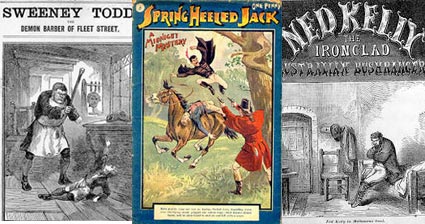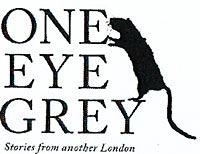|
Return of the Penny Dreadful
(Chris Roberts, 17th January, 2007)
Penny Dreadful or Penny Blood was initially a term applied to nineteenth century fiction magazines, in particular shocking serial stories with each section costing a penny. Over time though the phrase came to mean any down market gaudy fiction publication.
The Penny Dreadfuls were printed on poor quality paper and aimed primarily at the expanding urban working classes from the 1830s onwards. Some were reprints or reworkings of classic tales whilst others introduced fresh characters such as Varney the Vampire and the London folk demon Spring Heeled Jack.
In an interestingly modern twist Jack shifted from being a villain in the early texts to a hero of the people in later ones. Other popular outlaw characters included highwaymen and pirates. By the 1850s they had a huge readership.

Such publications were viewed with dismay by the moral authorities of Victorian England. They were happy that the dreadfuls encouraged literacy but appalled by their content.
In the 1890s, Alfred Harmsworth, reacted to this perceived corrupting influence by issuing new story papers for a half-penny.
He started out with high-minded tales but these soon went downmarket prompting A.A. Milne to wryly comment that; 'Harmsworth killed the penny dreadful by the simple process of producing the ha'penny dreadfuller.'

Over time more 'wholesome' comics such as Union Jack and upright characters such as Sexton Blake won out and these bled directly into the better known comics of the 20th century.
Sexton Blake was one of a few very popular personalities to come out of the Dreadfuls appearing in thousands of adventures right up into the 1970s. Another figure, Jack Harkaway, was very popular in America.
A good deal of the traffic was the other way though with American dime novels edited and rewritten for an English audience. This Americanisation was something that George Orwell bemoaned in his essay the Decline of English murder.
However if he had looked closer into 19th century English publications he would have found moral depravity was not something that the British needed to import.
Some writers did have moral points to make particularly about disparities of wealth and poverty. Whilst others enjoyed exposing vice amongst the upper classes. In a sense the roles that Oxfam, Hello Magazine and Pop Bitch provide today.
Many pennys though left little to the readers' imagination, presenting them with incestuous slums and pox ridden hells.
In these, to quote from the splendid History of Comics; 'pigs ate the bodies of newly dead babes and hardened undertakers' men fainted at the sights which met their eyes. Hump backed dwarfs, harridans and grave robbers groped past against a background of workhouses, gaols, execution yards, thieves' kitchens and cemeteries.'


It is these aspects that F and M Publications are hoping to resurrect in their 21st century Penny Dreadfuls (costing £2.50 in order to cover the inflated cost of delivery urchins).
There is also an old fashioned sense of anticipation and lack of immediacy.
The first series (One Eye Grey) will come out over a year in February, June and October, all on dates of occult significance. Both of the first two will have a cliff hanger ending leaving the reader anxious to know what happens next.
There is no point rushing into things as the horror will come soon enough anyway. One nod to twenty first century sensibilities is being made though as by the end of the year the series hopes to be carbon neutral and therefore not at all dreadful for the environment.
More info
 A history of comics A history of comics
 Penny dreadfuls in a historical horror context Penny dreadfuls in a historical horror context
 A defence of Penny Dreadfuls by GK Chesterton A defence of Penny Dreadfuls by GK Chesterton
 Comparison of video nasties and penny dreadfuls Comparison of video nasties and penny dreadfuls
If you'd like to contribute to future penny dreadful projects, visit www.fandmpublications.co.uk
|

